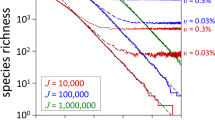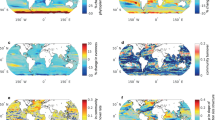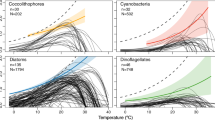Abstract
Climate strongly influences the distribution and diversity of animals and plants, but its affect on microbial communities is poorly understood. By using resource competition theory, fundamental physical principles and the fossil record we review how climate selects marine eukaryotic phytoplankton taxa. We suggest that climate determines the equator-to-pole and continent-to-land thermal gradients that provide energy for the wind-driven turbulent mixing in the upper ocean. This mixing, in turn, controls the nutrient fluxes that determine cell size and taxa-level distributions. Understanding this chain of linked processes will allow informed predictions to be made about how phytoplankton communities will change in the future.
This is a preview of subscription content, access via your institution
Access options
Subscribe to this journal
Receive 12 print issues and online access
$209.00 per year
only $17.42 per issue
Buy this article
- Purchase on Springer Link
- Instant access to full article PDF
Prices may be subject to local taxes which are calculated during checkout





Similar content being viewed by others
References
Canfield, D. E. & Thamdrup, B. The production of 34S-depleted sulfide during bacterial disproportionation of elemental sulfur. Science 266, 1973–1975 (1994).
Des Marais, D. J., Strauss, H., Summons, R. E. & Hayes, J. M. Carbon isotope evidence for the stepwise oxidation of the Proterozoic environment. Nature 359, 606–609 (1992).
Hayes, J. M., Strauss, H. & Kaufman, A. J. The abundance of 13C in marine organic matter and isotopic fractionation in the global biogeochemical cycle of carbon during the past 800 Ma. Chem. Geol. 161, 103–125 (1999).
Tappan, H. The Paleobiology of Plant Protists. (Freeman & Co, San Francisco, 1980).
Lipps, J. H. Plankton evolution. Evolution 24, 1–22 (1970).
Katz, M. E., Finkel, Z. V., Grzebyk, D., Knoll, A. H. & Falkowski, P. G. Evolutionary trajectories and biogeochemical impacts of marine eukaryotic phytoplankton. Annu. Rev. Ecol. Evol. Syst. 35, 523–556 (2004).
Yoon, H. S., Hackett, J. D., Ciniglia, C., Pinto, G. & Bhattacharya, D. A molecular timeline for the origin of photosynthetic eukaryotes. Mol. Biol. Evol. 21, 809–818 (2004).
Miller, K. G. et al. The Phanerozoic record of global sea-level change. Science 310, 1293–1298 (2005).
Crowley, T. & North, G. Paleoclimatology (Oxford Univ. Press, New York, 1991).
Rahmstorf, S. & Ganopolski, A. Long-term global warming scenarios computed with an efficient coupled climate model. Clim. Change 43, 353–367 (1999).
Margalef, R. in Perspectives in Marine Biology (ed. Buzzati-Traverso, A. A.) 323–349 (University of California Press, Berkeley, 1960).
Margalef, R. Turbulence and marine life. Sci. Mar. Suppl. 61, 109–123 (1997).
Munk, W. & Wunsch, C. Abyssal recipes II: energetics of tidal and wind mixing. Deep-Sea Res. I 45, 1977–2010 (1998).
Vallis, G. K. Large-scale circulation and production of stratification: effects of wind, geometry, and diffusion. J. Phys. Oceanogr. 30, 933–954 (2000).
Falkowski, P., Barber, R. & Smetacek, V. Biogeochemical controls and feedbacks on ocean primary production. Science 281, 200–206 (1998).
Laws, E. A., Falkowsk, P. G., Smith, W. O., Ducklow, H. & McCarthy, J. J. Temperature effects on export production in the open ocean. Glob. Biogeochem. Cycles 14, 1231–1246 (2000).
Redfield, A. C. The biological control of chemical factors in the environment. Am. Sci. 46, 205–221 (1958).
Eppley, R. W. & Peterson, B. J. Particulate organic matter flux and planktonic new production in the deep ocean. Nature 282, 677–680 (1979).
Sarmiento, J. L. & Bender, M. Carbon biogeochemistry and climate change. Photosyn. Res. 39, 209–234 (1994).
Volk, T. & Hoffert, M. I. Ocean carbon pumps: analysis of relative strengths and efficiencies in ocean-driven atmospheric CO2 changes. Geophys. Monogr. 32, 99–110 (1985).
Goldman, J. in Toward a Theory on Biological-Physical Interactions on the World Ocean (ed. Rothchild, B.) 273–296 (Kluwer Academic, Dordrecht, 1988).
Falkowski, P. G., Laws, E. A., Barber, R. T. & Murray, J. W. in Ocean Biogeochemistry: a JGOFS Synthesis (ed. Fasham, M.) 99–122 (Elsevier, New York, 2003).
Cullen, J. J., Franks, P. J. S., Karl, D. M. & Longhurst, A. in The Sea: Biological-Physical Interactions in the Sea (eds. Robinson, A. R., McCarthy, J. J. & Rothschild, B. J.) 297–336 (John Wiley & Sons, New York, 2002).
Smayda, T. J. The suspension and sinking of phytoplankton in the sea. Oceanogr. Mar. Biol. Ann. Rev. 8, 353–414 (1970).
Bienfang, P. K. & Ziemanm, D. A. in Primary Productivity and Biogeochemical Cycles in the Sea (eds. Falkowski, P. G. & Woodhead, A. D.) 285–298 (Plenum, New York, 1992).
Sancetta, C., Villareal, T. & Falkowski, P. G. Massive fluxes of rhizosolenoid diatoms: a common occurrence? Limnol. Oceanogr. 36, 1452–1457 (1991).
Dugale, R. & Wilkerson, F. in Primary Productivity and Biogeological Cycles in the Sea (eds Woodhead, A. D. & Falkowski, P. G.) 107–122 (Plenum, New York, 1992).
Jenkins, W. J. & Doney, S. C. The subtropical nutrient spiral. Glob. Biogeochem. Cycles [online], (2003).
Sarmiento, J. L. High latitude controls of thermocline nutrients and low latitude biological productivity. Nature 427, 56–60 (2004).
Ledwell, J., Watson, A. J. & Law, C. S. Evidence for slow mixing across the pycnocline from an open ocean tracer-release experiment. Nature 364, 701–703 (1993).
Sverdrup, H. U. On conditions for the vernal blooming of phytoplankton. J. Cons. Explor. Mer. 18, 287–295 (1953).
Denman, K. L. & Gargett, A. E. Time and space scales of vertical mixing and advection of phytoplankton in the upper ocean. Limnol. Oceanogr. 28, 801–815 (1983).
Stommel, H. An elementary explanation of why ocean currents are strongest in the west. Am. Meteorol, Soc. Bull. 32, 21–23 (1951).
Kolmogorov, A. N. Dissipation of energy in a locally isotropic turbulence. Dokl. Akad. Nauk SSSR 32, 141 (1941).
Tilman, D. Resource competition between planktonic algae: an experimental and theoretical approach. Ecology 58, 338–348 (1977).
Droop, M. R. Nutrient limitation in osmotrophic protista. Am. Zool. 13, 209–214 (1973).
Grover, J. P. Dynamics of competition among microaglae in variable environments: experimental tests of alternative models. OIKOS 62, 231–243 (1991).
Tozzi, S. Historical climate change and ocean turbulence as selective agents for two key phytoplankton functional groups. Mar. Ecol. Prog. Ser 274, 123–132 (2004).
Litchman, E., Klausmeier, C. A., Miller, J. R., Schofield, O. M. & Falkowski, P. G. Multi-nutrient, multi-group model of present and future oceanic phytoplankton communities. Biogeosciences 3, 585–606 (2006).
Tilman, D. Resource Competition and Community Structure (Princeton Univ. Press, Princeton, 1982).
Hutchinson, G. E. The paradox of the plankton. Am. Nat. 95, 137–145 (1961).
Siegel, D. Resource competition in a discrete environment: why are plankton distributions paradoxical? Limnol. Oceanogr. 43, 1133–1146 (1998).
Hardin, G. The competitive exclusion principle. Science 131, 1292–1297 (1960).
Karp-Boss, L. E., Boss, E. & Jumars, P. A. Nutrient fluxes to planktonic osmotrophs in the presence of fluid motion. Oceanogr. Mar. Biol. Ann. Rev. 34, 71–107 (1996).
Pasciak, W. J. & Gavis, J. Transport limitation of nutrient uptake in phytoplankton. Limnol. Oceanogr. 19, 881–888 (1974).
Munk, W. H. & Riley, G. A. Absorption of nutrients by aquatic plants. J. Mar. Res 11, 215–240 (1952).
Wolf-Gladrow, D. & Riebesell, U. Diffusion and reactions in the vicinity of plankton: a refined model for inorganic carbon transport. Mar. Chem. 59, 17–34 (1997).
Reynolds, C. S. Vegetation Processes in the Pelagic: a Model for Ecosystem Theory. 371 (Odendorf-Luhe, Germany,1997).
Smetacek, V. Diatoms and the ocean carbon cycle. Protist 150, 25–32 (1999).
Raven, J. A. The role of vacuoles. New Phytol. 106, 357–422 (1987).
Iglesias-Rodriguez, D. M. et al. Representing key phytoplankton functional groups in ocean carbon cycle models: Coccolithophorids. Glob. Biogeochem. Cycles [online] (2002).
Emiliani, C. Mineralogical and chemical composition of the tests of certain pelagic foraminifera. Micropaleontology 1, 377–380 (1955).
Falkowski, P. G. et al. The evolutionary history of eukaryotic phytoplankton. Science 305, 354–360 (2004).
Falkowski, P. G. & Knoll, A. H. (eds) Evolution of Primary Producers in the Sea (Academic, New York, 2007).
Falkowski, P. G. et al. The rise of oxygen over the past 205 million years and the evolution of large placental mammals. Science 309, 2202–2204 (2005).
Koistra, W., Gersonde, R., Medlin, L. & Mann, D. G. in Evolution of Primary Producers in the Sea (eds Falkowski, P. G. & Knoll, A. H.) 207–249 (Academic, New York, 2007).
Shackleton, N. J. Oxygen isotopes, ice volume, and sea level. Quat. Sci. Rev. 6, 183–190 (1987).
Fisher, A. G. in Catastrophes and Earth History (eds Berggren, W. A. & van Couvering, J. A.) 129–150 (Princeton Univ. Press, Princeton, 1983).
Finkel, Z. V., Katz, M., Wright, J., Schofield, O. & Falkowski, P. Climatically-driven evolutionary change in the size structure of diatoms over the Cenozoic. Proc. Natl Acad. Sci. USA 102, 8927–8932 (2005).
Oliver, M. J., Petrov, D., Ackerly, D., Falkowski, P. & Schofield, O. M. The mode and tempo of genome size evolution in eukaryotes. Genome Res. 17, 594–601 (2007).
Connolly, J. et al. Correlated evolution of cell volume and genome size in diatoms (Bacillariophyceae). J. Phycol. (in the press).
Bambach, R. K. Seafood through time: changes in biomass, energetics, and productivity in the marine ecosystem. Paleobiology 19, 372–397 (1993).
Follows, M. J., Dutkiewicz, S., Grant, S. & Chisholm, S. W. Emergent biogeography of microbial communities in a model ocean. Science 315, 1843–1846 (2007).
Levitus, S., Antonov, J. I., Boyer, T. P. & Stephens, C. Warming of the world ocean. Science 287, 2225–2229 (2000).
Bakun, A. Global climate change and intensification of coastal ocean upwelling. Science 247, 198–201 (1990).
Bopp, L., Aumont, O., Cadule, P., Alvain, S. & Gehen, M. Response of diatoms distribution to global warming and potential implications: a global model study. Geophys. Res. Lett. 32, L19606 (2005).
Biegala, I. C., Not, F., Vaulot, D. & Simon, N. Quantitative assessment of picoeukaryotes in the natural environment by using taxon-specific oligonucleotide probes in association with tyramide signal amplification-fluorescence in situ hybridization and flow cytometry. J. Appl. Environ. Microbiol. 69, 5519–5529 (2003).
Fuhrman, J. A. & Azam, F. Thymidine incorporation as a measure of heterotrophic bacterioplankton production in marine surface waters: evaluation and field results. Mar. Biol. 66, 109–120 (1982).
Ducklow, H. W. The bacterial component of the oceanic euphotic zone. FEMS Microbiol. Ecol. 30, 1–10 (1999).
Karl, D. M. Selected nucleic acid precursors in studies of aquatic microbial ecology. Appl. Environ. Microbiol. 44, 891–902 (1982).
del Giorgio, P. A. & Duarte, C. M. Respiration in the open ocean. Nature 420, 379–384 (2002).
Bekker, A. et al. Dating the rise of atmospheric oxygen. Nature 427, 117–120 (2004).
Richardson, L. Weather Prediction by Numerical Process (Cambridge Univ. Press, Cambridge, 1922).
Purcell, E. M. Life at low Reynolds Number. Am. J. Phys. 45, 3–11 (1977).
Acknowledgements
The authors' work on this topic was supported by the National Science Foundation (grant number OCE 0241023 PGF) and National Aeronautics and Space Administration (grant number 05-TEB/05-33 MJO and PGF).
Author information
Authors and Affiliations
Corresponding author
Ethics declarations
Competing interests
The authors declare no competing financial interests.
Related links
Glossary
- Aeolian
-
The continentally derived nutrient input that is transported by the wind.
- Ma
-
(Mega-annum). A unit of time that is equal to 1 million (106) years.
- Oligotrophic
-
An aquatic environment that has low levels of nutrient and algal photosynthetic production (for example, high mountain lakes or the open ocean).
- Primary producer
-
An organism that is the original source of organic material in an ecosystem — plants, algae or chemosynthetic microorganisms.
- Riverine
-
The continentally derived nutrient input that is transported by rivers and streams.
Rights and permissions
About this article
Cite this article
Falkowski, P., Oliver, M. Mix and match: how climate selects phytoplankton. Nat Rev Microbiol 5, 813–819 (2007). https://doi.org/10.1038/nrmicro1751
Issue Date:
DOI: https://doi.org/10.1038/nrmicro1751
This article is cited by
-
Analysis of morphological traits as a tool to identify the realized niche of phytoplankton populations: what do the shape of planktic microalgae, Anna Karenina and Vincent van Gogh have in common?
Hydrobiologia (2024)
-
Global climate-change trends detected in indicators of ocean ecology
Nature (2023)
-
Quantification of multiple environmental controls on lipid biomarkers in common marine diatoms and dinoflagellates
Marine Biology (2023)
-
Influence of nutrient supply on plankton microbiome biodiversity and distribution in a coastal upwelling region
Nature Communications (2022)
-
Size-dependent susceptibility of lake phytoplankton to light stress: an implication for succession of large green algae in a deep oligotrophic lake
Hydrobiologia (2022)



